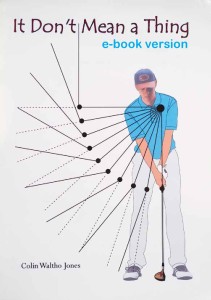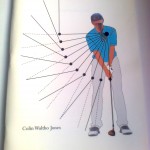This is a letter from me to John after meeting up.
Dear John,
Thanks for making the time to see us on Tuesday; I know what it’s like after a day at work. It was a fantastic location too with those views. And a great story about the snake (you’ll have to tell me it again; I keep getting the sequence wrong.)
The lecture we went to was very good. It was a Professor from Cambridge talking about evolution and how you can look at it a certain way and make a case for there being a God. He was an excellent speaker, unbelievably clever and went very easy on the “God” bit. Great brain food!
Thank you for telling me about your visit to the professional. I hope you weren’t worried about telling me. The only danger is that you start chasing solutions. And the only danger of that is that the process of chasing solutions is itself conscious. If, for instance, the professional notices that your hands are ahead of the ball (!), he’s probably right; it is just that the conscious thought “I must make sure my hands don’t get ahead of the ball” has the potential to disrupt the process of ensuring perfect timing. Having that thought before you start the round is neither here nor there, but thoughts and opinions have a nasty habit of invading ones mental space when one least wants them to do so.
Your blobs
33 points from 16 holes is better than handicap. The course may have been playing easier than usual but you were not hitting good drives and so to be playing better than your handicap over 16 holes when your driving is poorer than usual is testament to your all round game and to your competitive attitude.
You were pleased with your chip on the 1st and displeased with your drive on the 17th. The drive on the 17th is generally challenging because it is blind. Also, you know from experience that if you hit a good drive then a birdie is possible. By this point you had scored 33 points with 1 blob, and so you were naturally keen to get a good drive away to give yourself the chance of 3 points.
It is an enduring fascination of playing games that one’s natural desire to win is actually a threat to the physical actions that are likely to result in the desired outcome. In other words: when we most want it we are in danger of cocking it up. Remember Timothy Gallwey. He was motivated to seek enlightenment by a missed backhand volley on match point in the final of a national tournament. He was intrigued by the observation that his desire to hit a winning volley seemed to work against the chances of the volley being successful. Eventually he was happy enough to accept that the subconscious is responsible for the physical execution of the shot; that desire is a conscious emotion; and that desire can convince the conscious that it needs to take a bigger hand in directing the operations of the subconscious process. His subsequent success was based on devising methods of distracting the conscious so that the subconscious could get on with what it does best – hitting perfect shots.
My method works in a similar way except that with my method the conscious is distracted by giving it a role that actually helps the subconscious. The subconscious needs vivid visualization; it needs an uncluttered memory of pendulumic rhythm; it needs not to be distracted by ANYTHING!
Wanting a good drive to give yourself the chance of a birdie carries with it the threat of disrupting your subconscious process just enough to make the drive a little short of perfect. The disruption comes in the form of a lack of mental clarity when preparing for the shot. The subconscious still managed to deliver such an accurate force that the ball was propelled in pretty much the right direction, at pretty much the right launch angle (!) to get you 250 yards or so off the tee. Your golf swing is so grooved that it is really quite a robust mechanism. The problem is that anything short of perfection makes the next shot just that little bit more difficult, and when the margins are tight, over a whole round that can add up to something significant.
So, you are standing on the 17th tee and you want a birdie. The trick is to recognize “desire” for the good thing that it is; remember that it is a threat if you let it interfere in the method; remember also that you can use it to your advantage by making it add energy and focus TO the method, so that your visualization is sharper, your relaxed-ness more relaxed and your memory of a beautiful pendulumic rhythm more vivid. In fact, on this occasion, if you had used your desire to your advantage you would have been able to bring back to mind the rhythm of the chip on the 1st hole that had the ball behave exactly as envisioned.
Back to the tee shot: energized by the desire for a birdie you visualize a beautifully flighted drive out to the right, over the hill and drawing back on to the fairway. You replay this sizzling image over and over in your imagination as you take up your stance and settle over the ball. Immediately, you drop the image and bring back the memory of that chip on the first. You sense the ease of the stroke, the feeling of precise control, the feeling of the ball on the blade. As you take a breath, you get a sense of the ball sitting on the face of the driver. On the out-breath you play the shot.
Unlike your actual physical swinging of the club, that process, as I have just described it, is fragile. But it is only fragile in the context of attempting to produce perfection to order. You can get away with a muddled thought process and still play okay, but if you want to be able to virtually guarantee putting a slippery chip to 2 foot then you have to have clarity. And when the chips are down, having the knowledge that you know how to virtually guarantee perfection is very comforting.
Regards,
Colin


